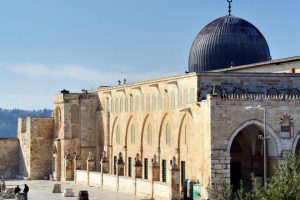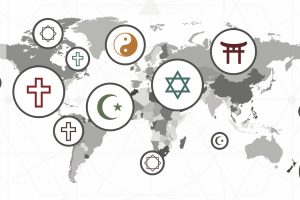
Fazal Ahmad, London, UK
Location: Samarkand, Uzbekistan
Belief: Islam
Date Opened: 1404 CE
Capacity: 10,000
After his conquest of India at the end of the 14th century, the great Mongol warrior king Timur (1336-1405) – who saw his mission as to punish unjust Muslim rulers, and who conquered Iran, Turkey, Mesopotamia, Russia, Syria, India and Iraq – returned to his native Samarkand and wanted to build the grandest and largest mosque in the world. He had already enhanced the Shah-i-Zinda mausoleum nearby in an attempt to make Samarkand the pilgrimage centre of central Asia and to rival Makkah.[1]
In 1399, he commanded a large team to drive the construction which was completed rapidly for a structure of this size. His team included some of the best craftsmen as well as ninety-five elephants. There were master craftsmen from Iraq, stonemasons from Azerbaijan and India, crystal workers from Syria as well as local craftsmen in Uzbekistan.[2]
The mosque, which could accommodate 10,000 worshippers, was named after Timur’s Chinese wife. Not long after the completion in 1404, elements of the mosque began to crumble, with bricks falling onto the worshippers. The haste (possibly through fear of angering Timur) meant perhaps not enough care had been taken on the design. An earthquake in 1897 caused further damage.
In the era of the Soviet Union, Russians prevented worshippers from using the mosque in order to suppress religion, and used the mosque as a stable and cotton market.[3]
The structure is still one of the largest Islamic structures in the world, with an entrance gate 120 feet high and an inner court 270 by 180 feet. The inner dome rises to 130 feet high.[4] The outside of the mosque is covered in beautiful Qur’anic inscriptions written in the Kufic script. Inside, the mosque is decorated with carved marble, terracotta, coloured tiles and gold.[5] At the centre of the prayer hall was a large marble lectern holding the 7th century Uthmanic Qur’an.
ENDNOTES
[1] Justin Marozzi, Tamerlane (UK: Harper Perennial, 2004), 230.
[2] Ibid, 225.
[3] Calum Macleod & Bradley Mayhew, Uzbekistan – The Golden Road to Samarkand (USA: Odyssey Publications Ltd, 1999), 163.
[4] Edgar Knobloch, Monuments of Central Asia (UK: I B Tauris Publishers, 2001), 103-104.
[5] Calum Macleod & Bradley Mayhew, Uzbekistan – The Golden Road to Samarkand (USA: Odyssey Publications Ltd, 1999), 163




Add Comment